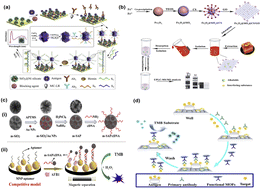Nanozyme-based sensors for detection of food biomarkers: a review
Abstract
Nanozymes have piqued the curiosity of scientists in recent years because of their ability to demonstrate enzyme-like activity combined with advantages such as high stability, inexpensive availability, robust activity, and tunable properties. These attributes have allowed the successful application of nanozymes in sensing to detect various chemical and biological target analytes, overcoming the shortcomings of conventional detection techniques. In this review, we discuss recent developments of nanozyme-based sensors to detect biomarkers associated with food quality and safety. First, we present a brief introduction to this topic, followed by discussing the different types of sensors used in food biomarker detection. We then highlight recent studies on nanozyme-based sensors to detect food markers such as toxins, pathogens, antibiotics, growth hormones, metal ions, additives, small molecules, and drug residues. In the subsequent section, we discuss the challenges and possible solutions towards the development of nanozyme-based sensors for application in the food industry. Finally, we conclude the review by discussing future perspectives of this field towards successful detection and monitoring of food analytes.

- This article is part of the themed collection: 2022 Reviews in RSC Advances


 Please wait while we load your content...
Please wait while we load your content...